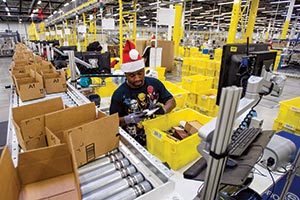Package Carriers Improve On-Time Delivery During Critical Holiday Shopping Season

This story appears in the Jan. 12 print edition of Transport Topics.
Package carriers dramatically improved their on-time delivery performance at the tail end of the Christmas shopping season, preventing a repeat of the delays that sparked a consumer outcry a year earlier.
During the 2013 holiday season, many late shipments did not arrive until after Dec. 25 as weather disruptions and an influx of online orders put a strain on delivery capacity.
This year, however, carriers took steps to enhance their service during the peak season, including hiring more employees and working more closely with retailers to better predict shipment volumes.
They also did not run into major weather challenges.
FedEx Corp., UPS Inc. and the U.S. Postal Service “put more emphasis on planning for the peak with more capacity addition to the hubs, with more temporary workers that were better trained and added earlier,” said Satish Jindel, president of ShipMatrix Inc., aprovider of logistics software to shippers.
According to tracking data collected by the firm, FedEx Express and UPS Express achieved about a 98% on-time rate for packages that were due for delivery on Christmas Eve.
That compares with a 90% on-time rate for FedEx and an 83% rate for UPS on Dec. 24, 2013.
UPS spokeswoman Susan Rosenberg pointed to that improvement as validation that the company was successful in meeting its commitments during the holiday season.
She said UPS emphasized collaborating with customers, including large retailers, to better align its capacity.
Those retailers realize that UPS is an important element of satisfying their customers, Rosenberg said.
“In fact, from an e-commerce perspective, we may be the physical presence for that company, so they want a smooth and positive delivery experience,” she said.
UPS also boosted its seasonal hires this year to 95,000 workers from about 85,000 last year, Rosenberg added.
In addition, the company added more work shifts and erected mobile delivery centers on lots adjacent to its facilities for more flexibility.
At the same time, weather conditions in December were much more favorable than a year ago.
“Last year, we faced some of the worst weather in the history of our company,” FedEx spokesman Tim Miller said.
“We took several actions to ensure we were as prepared as possible moving into the 2014 holiday season,” he added.
FedEx hired more than 50,000 seasonal workers, up from about 40,000 a year earlier, Miller said.
He also cited FedEx’s collaborative efforts with customers to better understand their volume needs.
UPS and FedEx are ranked No. 1 and 2, respectively, on the Transport Topics Top 100 list of the largest for-hire carriers in the United States and Canada.
Neither company had yet released final figures for their holiday shipment volumes, but both had projected record levels heading into the season.
In October, UPS said it expected to move more than 585 million packages in December, an 11% increase from the same timeframe a year earlier.
FedEx forecast that it would deliver more than 290 million shipments between Black Friday and Christmas Eve, up 8.8% year-over-year.
Meanwhile, the U.S. Postal Service said it delivered 524 million packages in December, up 18% from a year ago.
That included more than 28 million packages Dec. 22, the most in a single day in its history, the organization said.
The Postal Service said it delivered packages seven days a week beginning in late November to keep its networks clear during the holiday rush.
Heading into the holiday season, the National Retail Federation said it expected sales to rise 4.1% to $616.9 billion in November and December.
The trade organization also called for online sales to grow by 8% to 11% to as much as $105 billion.
Research firm ComScore Inc. said U.S. online retail spending from desktop computers totaled $53.3 billion in November and December, a 15% increase from a year ago.
The federal government’s record of retail sales will not be released until Jan. 14.
However, private retail-statistics tracker Johnson Redbook Service reported that its same-store sales index for December rose 5.2% from a year earlier. It also increased 3.2% excluding drug stores.
Rosenberg said UPS continues to plan for growth in e-commerce in the years ahead.
Business-to-consumer shipments are about 45% of all UPS deliveries, up from about 38% five years ago, she said.
Although Christmas is in the rearview mirror, package carriers still were wrapping up the peak delivery season in January with post-holiday returns, gift-card shopping and inventory replenishment.
UPS said it anticipated transporting 4 million return packages in the United States by the end of the first full week of 2015.
“There’s a lot of transportation activity that continues after Christmas,” Rosenberg said.

